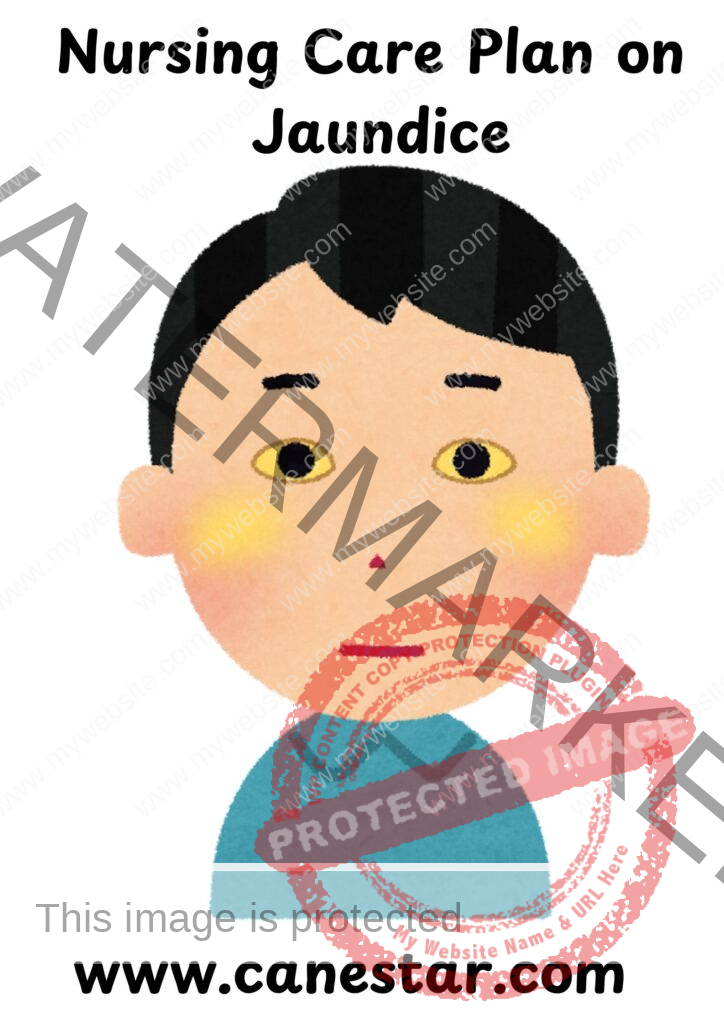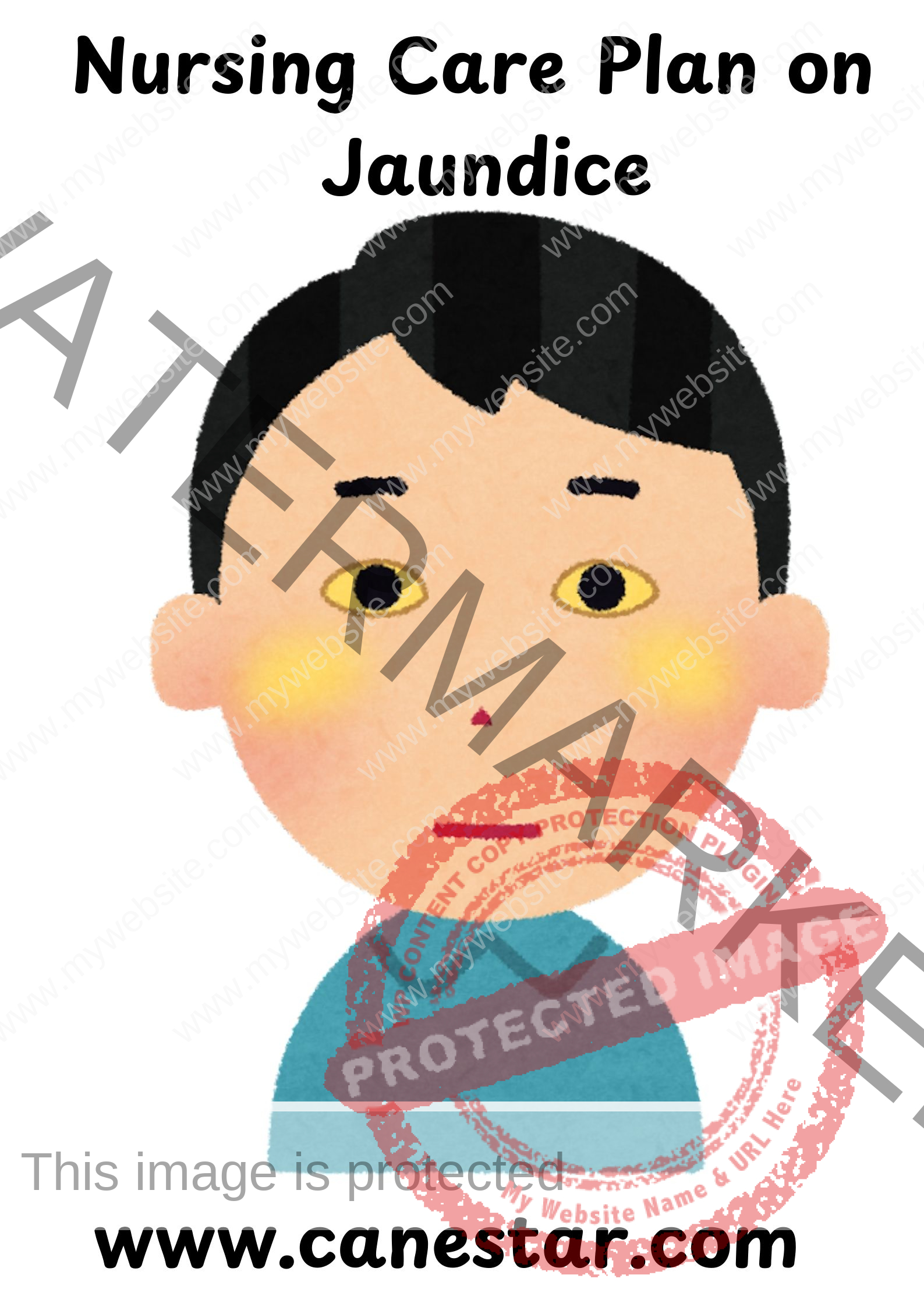NURSING CARE PLAN FOR JAUNDICE
NURSING CARE PLAN FOR JAUNDICE
NURSING CARE PLAN ON JAUNDICE
Jaundice is a condition where the skin, mucous membranes, and the whites of the eyes turn yellow due to an excess of bilirubin in the blood. Bilirubin is a yellow pigment that results from the breakdown of red blood cells, and it is normally processed by the liver.
Causes of Jaundice:
Jaundice occurs when there is a problem with the liver, bile ducts, or red blood cells. Some of the main causes include:
Pre-Hepatic Jaundice (Before the liver):
- Hemolysis: Excessive breakdown of red blood cells.
- Conditions like sickle cell anemia or malaria can lead to increased bilirubin production.
Hepatic Jaundice (At the liver):
- Liver diseases: Conditions such as hepatitis, liver cirrhosis, or liver cancer impair the liver’s ability to process bilirubin.
- Genetic disorders like Gilbert’s syndrome or Crigler-Najjar syndrome.
- Alcoholic liver disease and fatty liver disease.
Post-Hepatic Jaundice (After the liver):
- Obstruction of bile ducts: Conditions like gallstones, pancreatic cancer, or biliary atresia block the flow of bile, leading to jaundice.
- Cholestasis: Reduced or blocked bile flow due to various factors.
Symptoms of Jaundice:
- Yellowing of the skin and eyes.
- Dark-colored urine.
- Pale stools.
- Fatigue.
- Abdominal pain or discomfort (especially in the liver region).
- Itching (pruritus) due to bile salt deposits in the skin.
- Nausea or vomiting (in some cases).
Diagnosis:
To determine the cause of jaundice, the following tests and assessments are typically conducted:
Blood tests:
- Bilirubin levels (both direct and indirect bilirubin).
- Liver function tests (LFTs): Assess levels of enzymes like ALT, AST, ALP, and GGT.
- Complete blood count (CBC): To check for anemia or infection.
Imaging studies:
- Ultrasound: To assess the liver, bile ducts, and gallbladder.
- CT scan or MRI: Provides a detailed view of the liver and surrounding structures.
Liver biopsy (if needed): Helps to diagnose liver disease.
Treatment of Jaundice:
Treatment depends on the underlying cause:
Pre-Hepatic Jaundice:
- Treating hemolysis: Medications or interventions to stop the excessive breakdown of red blood cells.
Hepatic Jaundice:
- Medications for viral hepatitis or autoimmune diseases.
- Lifestyle modifications: Abstaining from alcohol or treating fatty liver disease.
- Liver transplant: In severe cases like cirrhosis or liver failure.
Post-Hepatic Jaundice:
- Surgical removal of gallstones or tumors.
- Endoscopic procedures: To remove obstructions in bile ducts.
- Stenting or drainage: For bile duct obstructions.
Complications:
- Chronic liver disease leading to cirrhosis or liver failure.
- Coagulopathy: Impaired blood clotting due to liver dysfunction.
- Hepatic encephalopathy: Confusion and altered mental status due to liver failure.
- Kidney failure: In severe cases of liver dysfunction.
Prevention:
- Vaccination against hepatitis (A and B) can prevent some forms of liver disease.
- Limit alcohol consumption to avoid alcoholic liver disease.
- Maintain a healthy diet and manage conditions like obesity and diabetes to prevent fatty liver disease.
- Avoid exposure to toxins and take medications as prescribed to prevent liver injury.
Prognosis:
The outlook for jaundice depends on the underlying cause. If treated early, many causes of jaundice can be effectively managed. However, untreated liver disease or bile duct obstructions can lead to serious complications.
Nursing Diagnosis:
Impaired Liver Function related to liver dysfunction secondary to jaundice as evidenced by yellow discoloration of the skin and sclera, dark urine, and laboratory abnormalities (e.g., elevated bilirubin levels).
Assessment:
Subjective Data:
- Patient may report fatigue, weakness, abdominal discomfort, pruritus (itching), and loss of appetite.
Objective Data:
- Yellowish discoloration of the skin and sclera.
- Dark urine and pale stools.
- Abnormal liver function tests (elevated bilirubin, ALT, AST).
- Nausea, vomiting, or weight loss.
Goals:
- Improve skin integrity and reduce itching.
- Promote comfort and manage fatigue.
- Promote adequate nutritional intake.
- Improve liver function and bilirubin levels.
- Prevent complications related to liver dysfunction.
Nursing Interventions:
Monitor and Assess:
- Monitor vital signs and observe for worsening symptoms (e.g., fever, confusion).
- Assess skin and sclera for changes in jaundice severity.
- Monitor lab results, including liver function tests (LFTs) and bilirubin levels.
- Assess for pruritus and skin breakdown due to itching.
Skin Care:
- Use warm (not hot) baths and mild soap to reduce irritation.
- Apply moisturizing creams or anti-itch medications (e.g., calamine lotion) as needed.
- Instruct the patient to avoid scratching to prevent skin breakdown.
- Encourage loose clothing to prevent further skin irritation.
Nutritional Support:
- Assess dietary intake and consult a dietitian for an appropriate liver-friendly diet (high carbohydrates, low fat).
- Encourage small, frequent meals to combat anorexia and nausea.
- Monitor weight regularly to assess for malnutrition.
- Encourage fluid intake to prevent dehydration (unless contraindicated due to liver function).
Medications:
- Administer prescribed medications to address the underlying cause of jaundice (e.g., antibiotics for infections, cholestyramine for pruritus).
- Administer vitamin supplements (such as fat-soluble vitamins A, D, E, K) if needed, as absorption may be impaired.
Comfort and Rest:
- Encourage rest periods to reduce fatigue.
- Promote a quiet environment to improve comfort and reduce stress.
- Teach relaxation techniques to help the patient cope with discomfort and fatigue.
Education:
- Educate the patient and family about jaundice and the importance of follow-up appointments to monitor liver function.
- Teach the patient about signs of complications (e.g., changes in mental status, increased pain, or bleeding tendencies) and when to seek medical help.
- Discuss the potential causes of jaundice (e.g., hepatitis, alcohol use, liver cirrhosis) and ways to avoid further liver damage.
Referral:
- Refer to a hepatologist if liver disease is severe or worsening.
- Refer to social services or counseling for patients with chronic liver disease to address any psychological or social concerns.
Evaluation:
Short-term goal:
- The patient’s bilirubin levels will decrease within the next few days.
- The patient will report less itching and discomfort.
Long-term goal:
- The patient will demonstrate improved liver function and reduced jaundice symptoms.
- The patient will maintain adequate nutritional intake and avoid complications like skin breakdown or infection.


